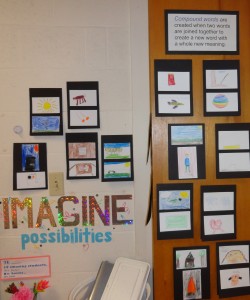We have reached the six-week milestone. We are settled into our classroom routine. The children seem to be feeling happy and settled  into our classroom. We have fun together reading, writing, “mathing” and creating together.
into our classroom. We have fun together reading, writing, “mathing” and creating together.
Knowing Yourself and How You Are Smart
Since the beginning of school we have been exploring how we are unique and have been examining how we are smart. We have been talking about how we can stretch and grow our intelligences through the choices we make. We have determined that we will each work to become our best selves – both as individuals and as a collective classroom community.
This week we have been thinking more of what it means to be a mathematician. When I first asked that question there was no response. Then someone shared that a mathematician solved problems and another said they had to visualize the problem and make a plan. Finally another said they needed to know numbers. This process was very different from our discussions of what it means to be a reader or a writer. I realized that we may not spend enough time learning about the process of becoming a thoughtful mathematician – we do math and we solve problems.
We shared the book Blockhead, a biography about Fibonacci. We talked about how he always thought of numbers, patterns and amounts. For several of the children it was the first time they had thought about Roman numerals or that counting and math were invented. Later we read The Cloak of a Dreamer where the characters create patterned cloaks to meet a deadline. From these two views of mathematics our list of what it means to be a mathematician expanded to include looking for patterns, measuring both distances and time and being creative.
I think our list is surprising to some of the children. It is very much like a list we generated in the first week of school about what it takes to be successful. I hope we will be able to stay with this work a bit longer so the children are able recognize the thinking strategies they use as they understand the language of mathematics and how they are the same as those they use to understand as they read and craft pieces of writing to communicate ideas.
School Alphabet Project
We have completed photographing our school alphabet. The children know more about using the camera and about light and composition. We had to retake some of the pictures because they were too dark or because the people in them made it challenging to know which letter the photograph actually represented. The plan is that the children will begin to use those skills to take pictures for the blog.
Those photographs will illustrate our growing handwriting model for the classroom. We know all the manuscript letters – shapes and sizes; and we are learning more and more of the cursive letters. This week’s set is the kite string letters. Perhaps your child can show you how some of those go.
The final piece of our alphabet project was to plan and create an alphabet book. We have read many alphabet books this year. They are not as simple as we first thought. Some of them are challenging like Animal Stackers with an acrostic for each animal featured on the page. Some are informative like Africa – ABC that is full of information and photographs for each letter. Some are quite funny like Alpha-Oops and Z is for Moose. We liked the funny ones best, but we also enjoyed the ones that challenged us to think. Our idea combines both. We will work to get our book done so we can share it with you next week.
We have been having fun with compound words and thinking about how two seemingly unrelated things come together to name a totally new thing. Last week we read the book Punnidles. That inspired us to make some of our own. They are outside our classroom door. If you happen by the school you might like to come down to see them. Compound words are a fun way to explore word categories.
NECAPS Underway
Thank you for the wonderful snacks. The children are enjoying the treats. Tuesday, our first test was fun. The second test on Thursday was a bit more challenging. The passages were longer and more varied and the questions seemed to require more inferencing. It was challenging and exhausting. You could feel the fatigue in the room. None-the-less, the children are working through them and doing their best work. You can be very proud of their effort. The reading sections will be done this week and then we launch into math.
Dates to remember –
NECAP dates – Math Tests – October 15, 16 and 18
Author Visit – Steve Cotler – October 17
